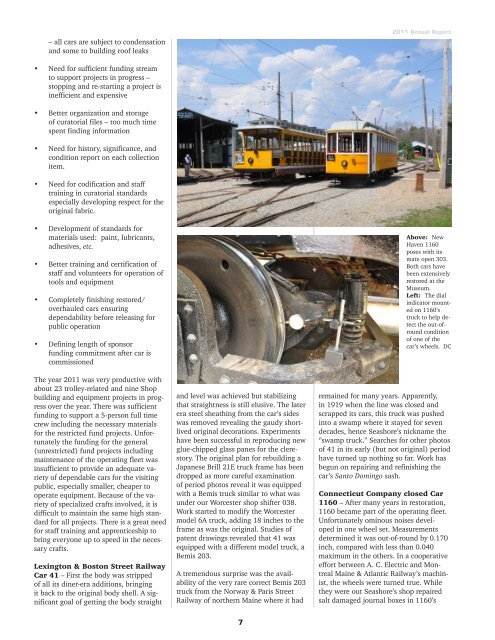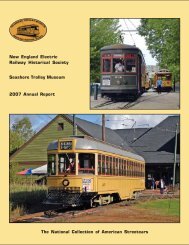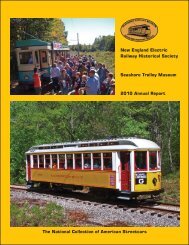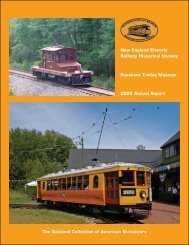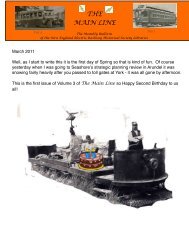2011 Annual Report - the Seashore Trolley Museum
2011 Annual Report - the Seashore Trolley Museum
2011 Annual Report - the Seashore Trolley Museum
You also want an ePaper? Increase the reach of your titles
YUMPU automatically turns print PDFs into web optimized ePapers that Google loves.
– all cars are subject to condensation<br />
and some to building roof leaks<br />
<strong>2011</strong> <strong>Annual</strong> <strong>Report</strong><br />
• Need for sufficient funding stream<br />
to support projects in progress –<br />
stopping and re-starting a project is<br />
inefficient and expensive<br />
• Better organization and storage<br />
of curatorial files – too much time<br />
spent finding information<br />
• Need for history, significance, and<br />
condition report on each collection<br />
item.<br />
• Need for codification and staff<br />
training in curatorial standards<br />
especially developing respect for <strong>the</strong><br />
original fabric.<br />
• Development of standards for<br />
materials used: paint, lubricants,<br />
adhesives, etc.<br />
• Better training and certification of<br />
staff and volunteers for operation of<br />
tools and equipment<br />
• Completely finishing restored/<br />
overhauled cars ensuring<br />
dependability before releasing for<br />
public operation<br />
• Defining length of sponsor<br />
funding commitment after car is<br />
commissioned<br />
The year <strong>2011</strong> was very productive with<br />
about 23 trolley-related and nine Shop<br />
building and equipment projects in progress<br />
over <strong>the</strong> year. There was sufficient<br />
funding to support a 5-person full time<br />
crew including <strong>the</strong> necessary materials<br />
for <strong>the</strong> restricted fund projects. Unfortunately<br />
<strong>the</strong> funding for <strong>the</strong> general<br />
(unrestricted) fund projects including<br />
maintenance of <strong>the</strong> operating fleet was<br />
insufficient to provide an adequate variety<br />
of dependable cars for <strong>the</strong> visiting<br />
public, especially smaller, cheaper to<br />
operate equipment. Because of <strong>the</strong> variety<br />
of specialized crafts involved, it is<br />
difficult to maintain <strong>the</strong> same high standard<br />
for all projects. There is a great need<br />
for staff training and apprenticeship to<br />
bring everyone up to speed in <strong>the</strong> necessary<br />
crafts.<br />
Lexington & Boston Street Railway<br />
Car 41 – First <strong>the</strong> body was stripped<br />
of all its diner-era additions, bringing<br />
it back to <strong>the</strong> original body shell. A significant<br />
goal of getting <strong>the</strong> body straight<br />
and level was achieved but stabilizing<br />
that straightness is still elusive. The later<br />
era steel sheathing from <strong>the</strong> car’s sides<br />
was removed revealing <strong>the</strong> gaudy shortlived<br />
original decorations. Experiments<br />
have been successful in reproducing new<br />
glue-chipped glass panes for <strong>the</strong> clerestory.<br />
The original plan for rebuilding a<br />
Japanese Brill 21E truck frame has been<br />
dropped as more careful examination<br />
of period photos reveal it was equipped<br />
with a Bemis truck similar to what was<br />
under our Worcester shop shifter 038.<br />
Work started to modify <strong>the</strong> Worcester<br />
model 6A truck, adding 18 inches to <strong>the</strong><br />
frame as was <strong>the</strong> original. Studies of<br />
patent drawings revealed that 41 was<br />
equipped with a different model truck, a<br />
Bemis 203.<br />
A tremendous surprise was <strong>the</strong> availability<br />
of <strong>the</strong> very rare correct Bemis 203<br />
truck from <strong>the</strong> Norway & Paris Street<br />
Railway of nor<strong>the</strong>rn Maine where it had<br />
Above: New<br />
Haven 1160<br />
poses with its<br />
mate open 303.<br />
Both cars have<br />
been extensively<br />
restored at <strong>the</strong><br />
<strong>Museum</strong>.<br />
Left: The dial<br />
indicator mounted<br />
on 1160’s<br />
truck to help detect<br />
<strong>the</strong> out-ofround<br />
condition<br />
of one of <strong>the</strong><br />
car’s wheels. DC<br />
remained for many years. Apparently,<br />
in 1919 when <strong>the</strong> line was closed and<br />
scrapped its cars, this truck was pushed<br />
into a swamp where it stayed for seven<br />
decades, hence <strong>Seashore</strong>’s nickname <strong>the</strong><br />
‘’swamp truck.” Searches for o<strong>the</strong>r photos<br />
of 41 in its early (but not original) period<br />
have turned up nothing so far. Work has<br />
begun on repairing and refinishing <strong>the</strong><br />
car’s Santo Domingo sash.<br />
Connecticut Company closed Car<br />
1160 – After many years in restoration,<br />
1160 became part of <strong>the</strong> operating fleet.<br />
Unfortunately ominous noises developed<br />
in one wheel set. Measurements<br />
determined it was out-of-round by 0.170<br />
inch, compared with less than 0.040<br />
maximum in <strong>the</strong> o<strong>the</strong>rs. In a cooperative<br />
effort between A. C. Electric and Montreal<br />
Maine & Atlantic Railway’s machinist,<br />
<strong>the</strong> wheels were turned true. While<br />
<strong>the</strong>y were out <strong>Seashore</strong>’s shop repaired<br />
salt damaged journal boxes in 1160’s<br />
7


